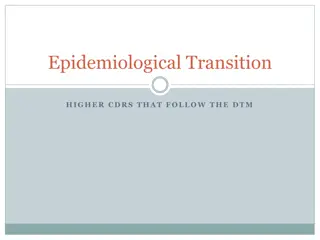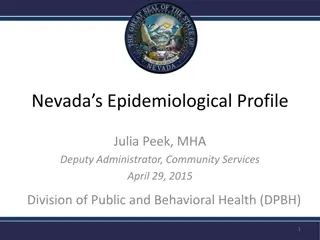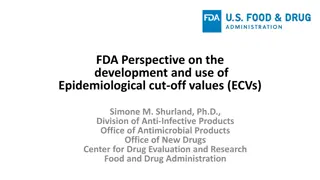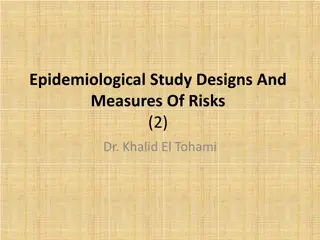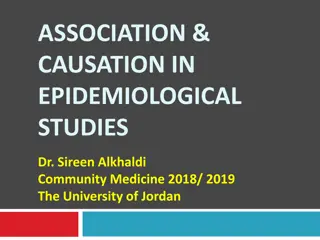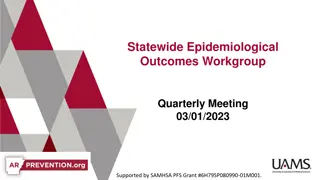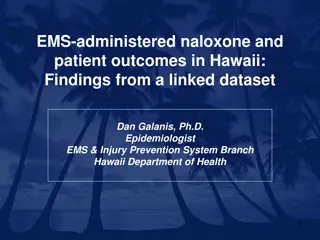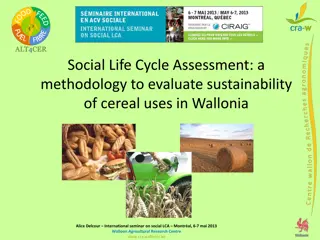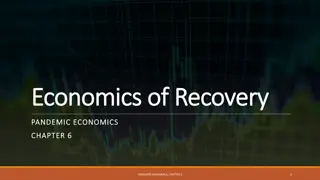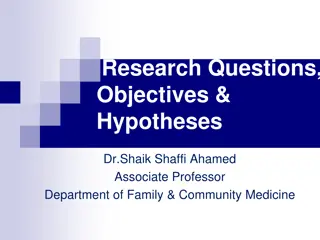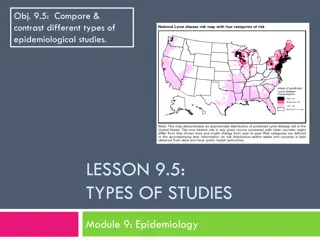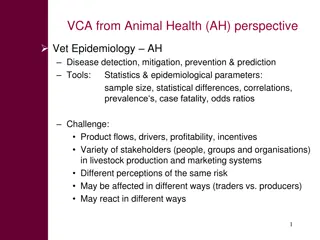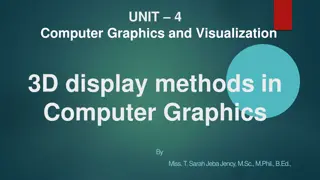Understanding Epidemiological Perspective: Definition, Scope, and Uses
Epidemiology is the scientific study of health-related states and events in populations, focusing on their distribution and determinants. This field helps in analyzing disease frequency, incidence, prevalence, mortality, and morbidity rates. Epidemiologists also examine disease distribution over time, place, and person to control health problems effectively.
Download Presentation

Please find below an Image/Link to download the presentation.
The content on the website is provided AS IS for your information and personal use only. It may not be sold, licensed, or shared on other websites without obtaining consent from the author. Download presentation by click this link. If you encounter any issues during the download, it is possible that the publisher has removed the file from their server.
E N D
Presentation Transcript
EPIDEMIOLOGICAL PERSPECTIVE: DEFINITION OF TERMS AND CONCEPTS, SCOPE AND USES TUNRAYO OLUWADARE DEPARTMENT OF COMMUNITY MEDICINE ABUAD
Introduction Overview of epidemiology
Definition of terms and concepts Epidemiology is the study of the distribution and determinants of health-related states or events (including disease), and the application of this study to the control of diseases and other health problems. WHO
Definition of terms and concepts contd. Epidemiology is the study (scientific, systematic, data-driven) of the distribution (frequency, pattern)and determinants (causes, risk factors) of health-related states and events (not just diseases) in specified populations (patients in community, individuals viewed collectively), and the application of (since epidemiology is a discipline within public health) this study to the control of health problems. CDC
Term Explanation Study Includes : surveillance, observation, hypothesis testing, analytical research and experiments Distribution Refers to analysis of : time, persons and places Determinants Includes: factors that influence health; biological, chemical, physical, social, cultural, economic, genetic and behavioural. Health-related states and events refer to: diseases, causes of death, behaviours such as use of tobacco, positive health states, reactions to preventive regimes and provision and use of health services. Specified populations include those with identifiable characteristics, such as occupational groups. Application to prevention and control the aims of public health to promote, protect, and restore health.
Definition of terms and concepts contd. Disease frequency It is summarizing the occurrence of disease, disabilities, death or health related events in form of rates and ratios Incidence rate Prevalence rate Mortality rate Morbidity rate
Definition of terms and concepts contd. Disease distribution Epidemiologists examines whether there is an increase or decrease in disease/health related events over time span . It is in terms of person , place and time (PPT) Determinants of disease
Definition of terms and concepts contd. Epidemic It is the unusual occurrence in a community or region of disease, specific health related events clearly in excess of expected occurrence.
Definition of terms and concepts contd. Endemic It refers to the constant presence of a disease or infectious agent within a given geographical area or population group, without importation from outside. It may also refer to the usual or expected frequency of disease within such area or population group. Hyperendemic It expresses that the disease is continually present at a high incidence and/or prevalence rate and affects all age group equally. Holoendemic It is a high level of infection beginning early in life and affecting most of the child population.
Questions A sporadic disease can become epidemic under favourable conditions An endemic disease under favourable conditions can become Holoendemic Epidemic Endemic Hyperendemic What form of endemic is Malaria Endemic Hyperendemic Epidemic Holoendemic
Definition of terms and concepts contd. Pandemic It is an epidemic affecting a large proportion of the population , occurring over a wide geographical area such as a section of a nation, the entire nation, a continent or the world. Eg influenza pandemic, COVID-19 pandemic Sporadic This is when cases occur irregularly , haphazardly from time to time.
Definition of terms and concepts contd. Zoonoses It is an infection or disease that is transmissible under natural conditions from animals to man, it may be enzootic or epizootic. Forms of zoonosis Antropozoonosis: infection transmitted to man from vertebrate animals eg. , rabies, plague , antrax etc. Zooantroponosis: infections from man to vertebrate animals e.g., human tuberculosis in cattle Amphixenosis: infections maintained in both man and lower vertebrates that may be transmitted in either direction e.g., T.cruzi, S. japonicum
Definition of terms and concepts contd. Host Is a person or animal , including arthropods and birds that affords subsistence or lodgement to an infectious agent under natural conditions. obligate host means the only host, e.g., man in measles and typhoid fever. Definitive/Primary hosts are those in which the parasite attains maturity or passes its sexual stage. Secondary/Intermediate hosts are those in which the parasite is in a larval or asexual state A transport host is a carrier in which the organism remains alive but does not undergo development.
Definition of terms and concepts contd. Exotic These are diseases that are imported into a country in which they do not otherwise occur. Contagious disease A disease that is transmitted through contact Communicable diseases Are diseases due to a specific infectious agent capable of being directly or indirectly transmitted from man to man, animal to animal, or from the environment to man or animal
Definition of terms and concepts contd. Contamination The presence of an infectious agent on a body surface, also on or in clothes, beddings, toys, surgical instruments or dressings, or other inanimate articles or substances including water, milk and food. Infestation It is the lodgement, development and reproduction of arthropods on the surface of the body or in the clothing, e.g., lice, itch mite.
Definition of terms and concepts contd. Infection The entry and development or multiplication of an infectious agent in the body of man or animals. An infection does not always cause illness. subclinical or inapparent infection (e.g., polio) latent infection (e.g., virus of herpes simplex) manifest or clinical infection.
Definition of terms and concepts contd. Surveillance Is the continuous scrutiny of the factors that determine the occurrence and distribution of disease and other conditions of ill health. Nosocomial infection/hospital acquired It is an infection originating in a patient while in a hospital or other health care facility.
Definition of terms and concepts contd. Eradication Termination of all transmission of infection by extermination of the infectious agent through surveillance and containment . Eradication is an absolute process, an "all or none" phenomenon, restricted to termination of an infection from the whole world.
Definition of terms and concepts contd. Cases Is defined as a person in the population or study group identified as having the particular disease, health disorder or condition under investigation. Carrier Is defined as an infected person or animal that harbors a specific infectious agent in the absence of discernible clinical disease and serves as a potential source of infection for others.
Definition of terms and concepts contd. Opportunistic infection This is infection by an organism(s) that takes the opportunity provided by a defect in host defence to infect the host and hence cause disease.
Uses Assessing community health Making individual decisions Completing the clinical picture Searching for causes
Uses Assessing community health Descriptive epidemiology. What are the actual and potential health problems in the community? Where are they occurring?
Uses contd. Assessing community health Which populations are at increased risk? Which problems have declined over time? Which ones are increasing or have the potential to increase? How do these patterns relate to the level and distribution of public health services available?
Uses contd. Making individual decisions When persons decide to quit smoking, climb the stairs rather than wait for an elevator, or use a condom, they may be influenced, consciously or unconsciously, by epidemiologists' assessment of risk.
Uses contd. Completing the clinical picture For example, in late 1989, a physician saw three patients with unexplained eosinophilia (an increase in the number of a specific type of white blood cell called an eosinophil) and myalgia (severe muscle pains). Although the physician could not make a definitive diagnosis, he notified public health authorities.
Uses contd. Completing the clinical picture More recently, epidemiologists, clinicians, and researchers around the world have collaborated to characterize SARS, a disease caused by a new type of coronavirus that emerged in China in late 2002 and late 2019.
Uses contd. Searching causes Much epidemiologic research is devoted to searching for causal factors that influence one's risk of disease. Ideally, the goal is to identify a cause so that appropriate public health action might be taken.
Uses contd. Searching causes contd. Examples date from the removal of the handle from the Broad St. pump following John Snow's investigation of cholera in the Golden Square area of London in 1854.
Presentation 1 Discuss extensively the mode of disease transmission Life cycle of Plasmodium



